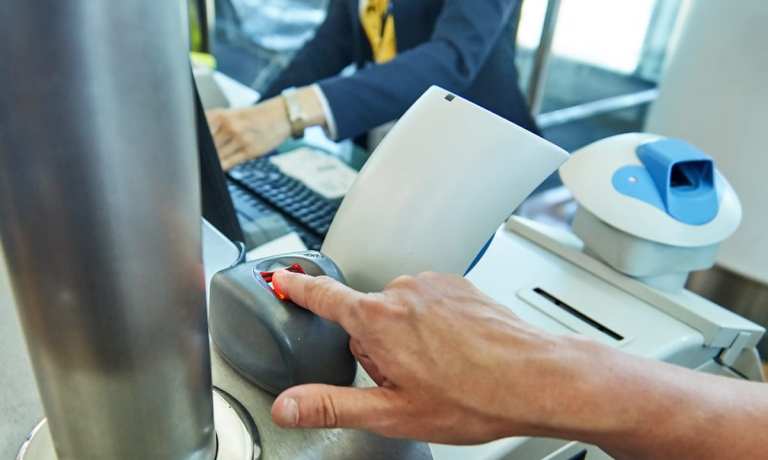
Biometrics are poised to make the leap beyond airports, and to act as a passport to any number of environments where crowds gather in the post-COVID reopening.
To that end, biometric security firm CLEAR filed its S-1 with the Securities and Exchange Commission (SEC), paving the way for an initial public offering (IPO) on the New York Stock Exchange.
CLEAR may arguably be best known for its origin that ties into creating “a frictionless travel experience while enhancing homeland security,” as described in the prospectus. At a high level, the company’s biometric security service offers subscriptions to its services, speeding up passenger flow through TSA lines at the airport.
But branching into other use cases shows how fungible, in a way, biometrics tech can be, where knowing who is who — for admission, for security or for commerce — is a key deployment. But along the way, as CLEAR’s filing shows, the pivot beyond travel — where demand is only now recovering from the ravages of the pandemic — will help determine whether the firm will see ignition. CLEAR points to the “convenience economy” as a key driver for using biometrics in a bid to streamline everyday interactions.
Tracking The Enrollments
Digging into the prospectus, since inception, there have been 5.6 million cumulative enrollments, with 61 million cumulative use cases across its platform.
Along with the decline in travel-related activity, first-quarter revenues slipped 17 percent as U.S. domestic flyers slipped by 60 percent. But the company remarked in its prospectus that a trend in its favor will be the “reopening of and return to secular growth in the travel industry … as the penetration of COVID-19 vaccinations increases, we believe the travel industry will reopen and return to secular growth.”
Against that backdrop, CLEAR said, even as travel declined, cumulative enrollments on the platform were up more than 12 percent, to 5.2 million. Looking across the entire year, revenue was up 20 percent to 230.8 million in 2020, while net loss narrowed to $9.3 million from $54.2 million.
Moreover, the company has debuted its Health Pass app, which stores healthcare-related data such as COVID test and vaccine records, which can help members show credentials required to, say, enter a sporting event. CLEAR said in its prospectus that it has partnered with 26 sports and entertainment partners and 67 Health Pass-enabled partners. That reach helps give coverage to 110 locations, including offices, theaters and theme parks.
Launched in 2010, CLEAR’s biometric security service is popular among frequent fliers, who purchase subscriptions for $179 a year. Along with gaining the ability to speed through airport lines, subscribers can also use the service at sports stadiums and entertainment venues.
Looking Toward Scale
“As we add partners, products and locations, our platform becomes more valuable to our members,” said CLEAR. “In turn, as we grow memberships, our platform is more valuable to our existing and prospective partners. This is evident in our accelerated growth rate since inception — it took seven years to reach our first million members, but less than one year to reach each of our second, third, fourth and fifth million members.”
CLEAR defines the total addressable markets, by vertical, as being rather significant. In aviation and travel, 90 million American adults fly at least twice annually, while 31 million fly at least six times annually. In hospitality, there were 1.3 billion room nights occupied in 2019, pre-pandemic, in the U.S. Per data from ESPN, across major sports leagues, there were 130 million sports attendees in 2019.
The movement into adjacent use cases depends on how many consumers embrace $179 annual subscriptions (the price of Clear PLUS), and whether the populations that do so will justify partners signing on with the technology platform.
In an interview with Karen Webster, Ken Cornick, co-founder and president of CLEAR, said that “our operating [thesis] is that, going forward, security demands are going to grow, not diminish — and identity is a key element of security. It’s not just airports, but any physical environment. We want to build the bridge that connects the gap between the need for security and the need for friction-free experiences.”
The airport, he told Webster, is in many ways the ideal starting place for biometrics and the platform economy. “First of all, if it’s strong enough to get on an airplane with, you can use it anywhere,” Cornick noted.
In other evidence of the lure of biometrics as a growth industry, LoginID, a FIDO-certified authentication provider, said earlier this month that it has garnered an additional investment from Visa for an undisclosed amount, on top of the firm’s seed funding round via FinTech investors announced in March. The Visa announcement comes as advanced technologies are increasingly being used to verify users. PYMNTS has estimated that as many as 18 billion transactions will be verified using biometrics this year.
[catlist tags=”Biometrics” post_type=”post” numberposts=”4″ orderby=”date” excludeposts=”this”